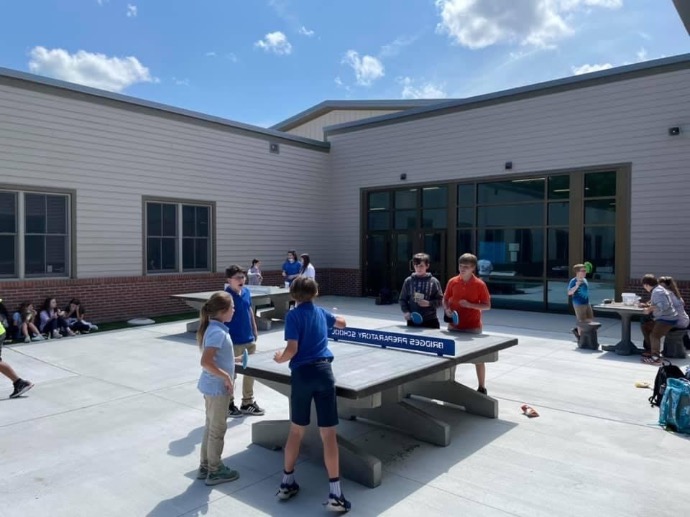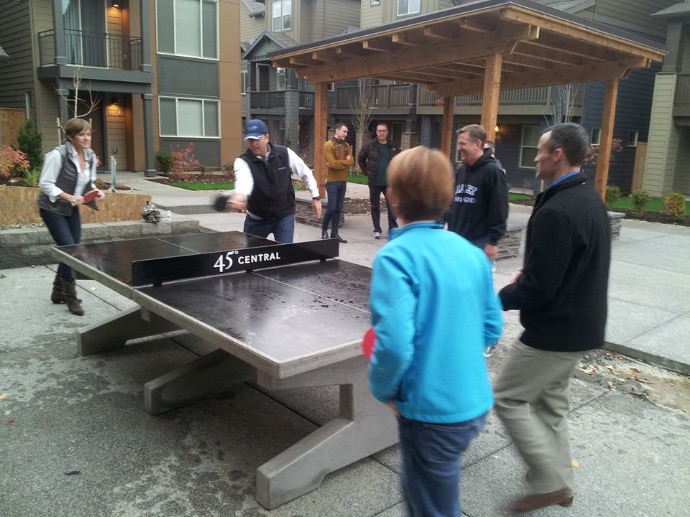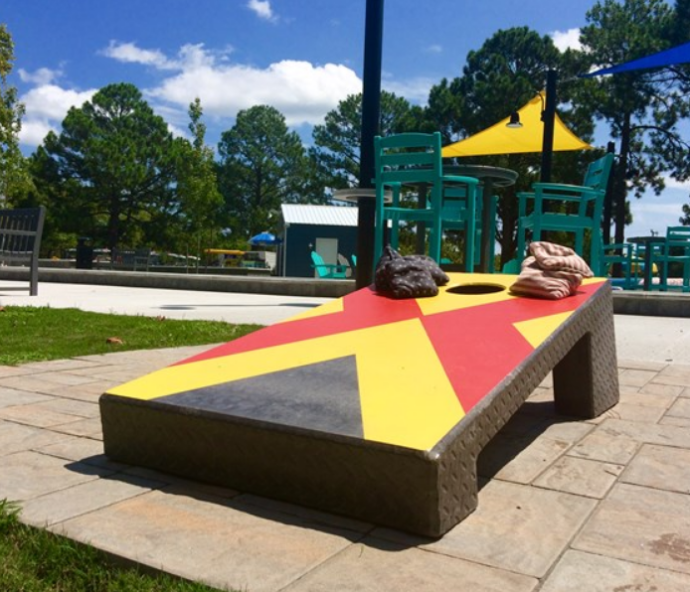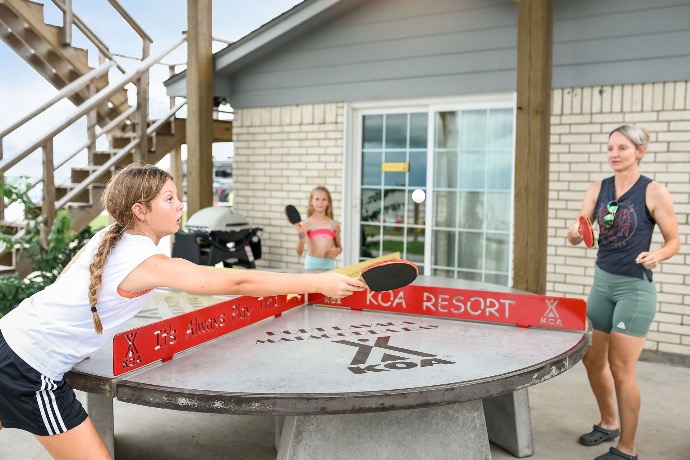Every city planner, school principal, or resort manager knows the value of a lively gathering spot. But not every project has the budget or staff to build a full community center. The good news? You don’t need one. With the right design choices, an ordinary courtyard, patch of grass, or plaza can become a novel community space — a place where neighbors connect, families play, and visitors feel at home.
That’s exactly what happens when you install concrete ping pong tables, foosball tables, cornhole boards, shuffleboard, or chess tables from Stone Age. These aren’t just games; they’re permanent touchpoints that transform overlooked corners into outdoor community centers — always open, always in the sunshine, and always delivering connection.
Below are the ten most common needs we hear from our customers, in their own words — and how outdoor concrete games have become their answer.
1. “We need something that actually survives outdoors.”
“I can’t keep buying equipment that falls apart every two years. Wood rots. Metal rusts. Portable nets snap. I want something permanent that I don’t have to replace.”
This is where concrete ping pong tables and foosball tables change the game. Unlike wood or metal, concrete doesn’t warp, rust, or splinter. Our tables are engineered to stay outdoors through every season — rain, snow, sun, or coastal salt air — and they play as well in year ten as they did on day one.

Permanent Games
For parks managers, durability isn’t just convenience. It’s the difference between a budget sinkhole and an investment that pays off for decades.
2. “Our spaces look nice, but no one uses them.”
“We’ve invested in landscaping and benches, but people don’t linger. We need something that draws people in — something active.”
Adding concrete ping pong tables or a bank of concrete cornhole boards instantly changes the atmosphere. Empty plazas turn into gathering spots. Courtyards that were just cut-through spaces become destinations.
In Coquitlam, B.C., the city installed multiple outdoor ping pong tables. Before long, regular competitive groups formed. Now residents meet weekly, rain or shine, with their own informal tournaments. No staff schedules them. No marketing campaign required. The tables themselves created the rhythm of community.
3. “We need activities for everyone, not just kids.”
“Playgrounds are great for the little ones, but what about the teens, parents, and grandparents? We need something everyone can enjoy together.”

Playfulness Transcends Age
“Playgrounds are great for the little ones, but what about the teens, parents, and grandparents? We need something everyone can enjoy together.”
That’s why principals and parks directors choose concrete chess, foosball, shuffleboard, and ping pong tables. These games cut across generations and abilities.
Some middle schools report an unexpected bonus: semester-long tournaments that include both students and staff. Teachers play alongside their classes. Principals even jump into matches. The games build a culture of inclusion that playground slides simply can’t.
4. “We don’t have the budget for ongoing maintenance.”
“Every time I turn around, we’re replacing something — nets, paddles, warped boards. I need something that doesn’t come with a permanent maintenance contract.”
Outdoor concrete games are as close to maintenance-free as it gets. No moving parts to break. No nets to restring. No boards to repaint. A quick rinse keeps them looking new.
For budget-conscious managers, that means real savings — year after year. The games aren’t just amenities; they’re reliable infrastructure.
5. “We’ve had too many problems with theft and vandalism.”
“If it’s portable, it disappears. If it’s light, it gets flipped or broken. I can’t keep chasing after missing equipment.”

Replacing Cornhole Every Month?
That’s why communities turn to concrete cornhole boards, foosball tables, and chess tables. They’re simply too heavy to move and built to withstand rough use. Even graffiti is easy to wash away.
Instead of worrying about replacement costs, managers can focus on the positive: a piece of park equipment that anchors the space and stays put.
6. “We don’t have the budget for a full playground.”
“We’d love to install a big play structure, but the numbers just don’t work. We need a lower-cost way to activate our parks.”
A playground can run into six figures and often serves only one age group. By contrast, a cluster of concrete ping pong tables and cornhole boards creates massive community impact for a fraction of the price.
That means more projects get approved, and more neighborhoods get meaningful recreation.
7. “We need to show that our investments matter.”
“When we spend public funds, we have to show real community return. Benches are nice, but they don’t build community engagement.”
In Shreveport, Louisiana, city parks installed about a dozen sets of concrete cornhole boards across several neighborhoods. The result was immediate: neighbors gathering weekly for cornhole sessions, building bonds and routines around the game.
That’s measurable engagement. It’s not just furniture in a park — it’s a program without staff, running itself every week.
8. “We want something unique, not cookie-cutter.”
“We don’t want the same equipment as every other community down the road. We want something that reflects our identity.”
That’s where customused concrete game tables shine. With inlaid tile, memorial plaques, or even branded designs, these tables become more than games. They’re stories, memories, and symbols.

Branded Concrete Games Build Community Identity
Whether it’s a school honoring a class legacy with a custom table, or an apartment complex showcasing its logo, design flexibility makes the games feel owned by the community.
9. “We want to bring people together.”
“Our guests want more than amenities. They want connection. We need things that make strangers into friends.”
Games like ping pong, foosball, and cornhole naturally break the ice. A paddle in hand, a beanbag toss, a friendly challenge — suddenly, people are laughing and talking.
At resorts, that can mean strangers becoming friends over a weeklong stay. In apartments, it can mean neighbors who’ve never spoken suddenly sharing a cornhole match.
10. “We need an alternative to screens.”
“Too many of us are staring at phones. We need ways to get them outside, face-to-face, doing something real.”
Outdoor games are a natural antidote. Multiple ping pong tables side by side create impromptu tournaments. Rows of concrete cornhole boards invite spirited competitions. Foosball and shuffleboard add variety.
These aren’t passive diversions. They’re active, social, and addictive in the best possible way — creating healthier patterns of play and connection.
Real-World Outdoor Community Centers
The most exciting part is what happens after installation. Time and again, communities discover that these games don’t just fill space — they create structure.
- Coquitlam, B.C.: Regular table tennis groups formed on their own around city ping pong tables. Informal, reliable, and self-sustaining.
- Shreveport, Louisiana: A dozen cornhole installations turned into weekly neighborhood gatherings. No staff, no schedule — just community.
- Schools across the U.S.: Semester-long tournaments involve entire student bodies and staff, blending play with school culture.
- Resorts nationwide: Courtyards that were once quiet now host laughter, competition, and connection every evening.
Outdoor Community Centers: No Staff Required
When you add Stone Age concrete games, you’re not just buying equipment. You’re building outdoor community centers — permanent, self-sustaining gathering places.
They don’t require programming. They don’t require staffing. They don’t wear out in a few seasons. They simply invite play, day after day, for decades.
For parks directors, resort managers, and school principals, that’s the kind of investment that pays off not just on paper, but in joy, laughter, and community strength.
Conclusion: A Small Investment with Lasting Impact
Every community has overlooked spaces — corners of parks, underused courtyards, apartment greenspaces. With the right installations, those empty areas can become novel community spaces where connection thrives.
Concrete ping pong, foosball, cornhole, chess, and shuffleboard tables are the tools. What they build is bigger: neighbors who know each other, students who play together, families who gather outside, and communities that feel alive.
At Stone Age, we believe joy is infrastructure. And when it’s built from concrete, it lasts for generations.